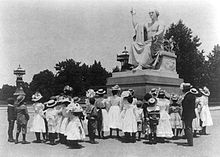
Thomas Ball was an American sculptor and musician. His work has had a marked influence on monumental art in the United States, especially in New England.

Attilio Piccirilli was an American sculptor. Born in Massa, Italy, he was educated at the Accademia di San Luca of Rome.

The United States Capitol rotunda is the tall central rotunda of the United States Capitol in Washington, D.C. It has been described as the Capitol's "symbolic and physical heart". Built between 1818 and 1824, the rotunda is located below the Capitol dome, which was built between 1857 and 1866.

Franklin Bachelder Simmons was a prominent American sculptor of the nineteenth century. Three of his statues are in the National Statuary Hall Collection, three of his busts are in the United States Senate Vice Presidential Bust Collection, and his statue of Ulysses S. Grant is in the United States Capitol Rotunda.
The Greek Slave is a marble sculpture by the American sculptor Hiram Powers. It was one of the best-known and critically acclaimed American artworks of the nineteenth century, and is among the most popular American sculptures ever. It was the first publicly exhibited, life-size, American sculpture depicting a fully nude female figure. Powers originally modeled the work in clay, in Florence, Italy, completing it on March 12, 1843. The first marble version of the sculpture was completed by Powers' studio in 1844 and is now in Raby Castle, England.

The Hall of Columns is a more than 100-foot-long (30 m) hallway lined with 28 fluted columns in the south wing extension of the United States Capitol in Washington, D.C. It is also the gallery for 18 statues of the National Statuary Hall Collection.

Horatio Greenough was an American sculptor best known for his United States government commissions The Rescue (1837–50), George Washington (1840), and The Discovery of America (1840–43).
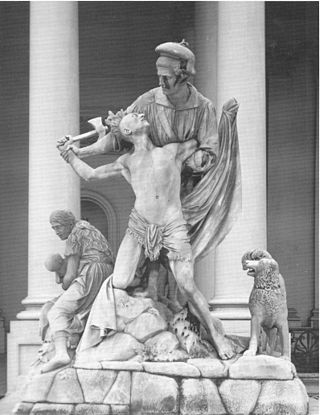
The Rescue (1837–1850) is a large marble sculpture group which was assembled in front of the east façade of the United States Capitol building and exhibited there from 1853 until 1958, when it was removed and never restored. The sculptural ensemble was created by sculptor Horatio Greenough (1805–1852) who had previously been commissioned by the U.S. government to create a massive sculpture, George Washington (1832–1841) for the Capitol rotunda, also now removed from that site.

The Discovery of America is a large marble sculptural group, created by Luigi Persico, which adorned the front of the east façade of the United States Capitol building from 1844 to 1958, before being put into storage.

Brenda Putnam was an American sculptor, teacher and author.
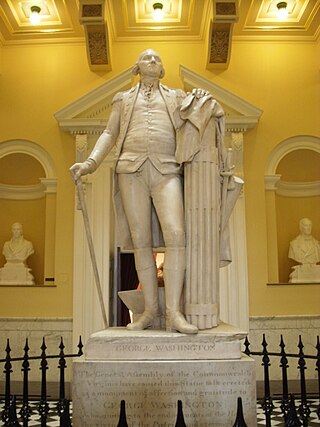
George Washington is a statue by the French sculptor Jean-Antoine Houdon from the late 18th century. Based on a life mask and other measurements of George Washington taken by Houdon, it is considered one of the most accurate depictions of the subject. The original sculpture is located in the rotunda of the Virginia State Capitol in Richmond, Virginia, and it has been copied extensively, with one copy standing in the United States Capitol Rotunda.
Gaetano Cecere, was an American sculptor. He was born, educated and worked in New York City. He studied with Hermon A MacNeil, with work in the Museum of Modern Art in New York City, and Gaetano, known as "Guy," attended the Beaux-Arts Institute of Design and the National Academy of Design. In 1920 he won the Prix de Rome and studied at the American Academy in Rome for several years. During this period a "tendency to simplify forms for decorative effects was developed." Cecere has works and documents housed in many major museums and collections, including the Smithsonian Institution, the "National Collection of Fine Arts" and the Archives of American Art".

John Frazee was an American sculptor and architect. The Smithsonian has a collection of many of his sculptures as well as paintings of Frazee by other artists including Asher B. Durand and Henry Colton Shumway.

George Washington is a marble bust portrait of George Washington, done in the style of a Roman emperor, by the Italian sculptor Giuseppe Ceracchi. It was created as part of a campaign by Ceracchi to build a larger monument to Washington. The bust was thought by many to be one of the most lifelike. It was later used as a model of Washington for works by other sculptors and engravers.
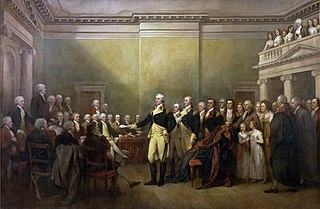
General George Washington Resigning His Commission is a large-scale oil painting by American artist John Trumbull of General George Washington resigning his commission as commander-in-chief of the Continental Army on December 23, 1783 to the Congress of the Confederation, then meeting in the Maryland State House at Annapolis, Maryland. The painting was commissioned in 1817, started in 1822, finished in 1824, and is now on view in the United States Capitol rotunda in Washington, D.C., along with three other large-scale paintings by Trumbull about the American Revolutionary War.

George Washington's resignation as commander-in-chief marked the end of Washington's military service in the American Revolutionary War and his return to civilian life at Mount Vernon.

George Washington was a life-size marble statue of George Washington, done in the style of a Roman general, by the Venetian-Italian Neoclassical sculptor Antonio Canova. Commissioned by the State of North Carolina in 1815, it was completed in 1820 and installed in the rotunda of the North Carolina State House on December 24, 1821. The building and the statue were destroyed by fire on June 21, 1831. This work was the only one created by Canova for the United States.

A statue of American Founding Father and U.S. President Thomas Jefferson by the French sculptor David d'Angers stands in the Capitol rotunda of the U.S. Congress. Jefferson is portrayed holding a copy of the United States Declaration of Independence, which he mainly drafted in 1776 as a member of the Committee of Five during the Second Continental Congress. The painted plaster model also stood in the chambers of the New York City Council.
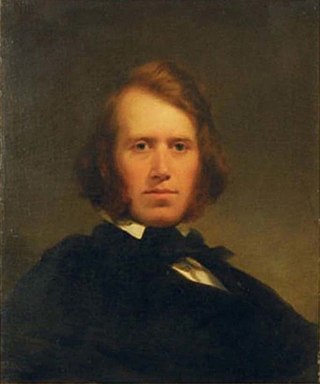
Horatio Stone, was an American sculptor, physician, and writer. He is best remembered for his three statues in the U.S. Capitol.

